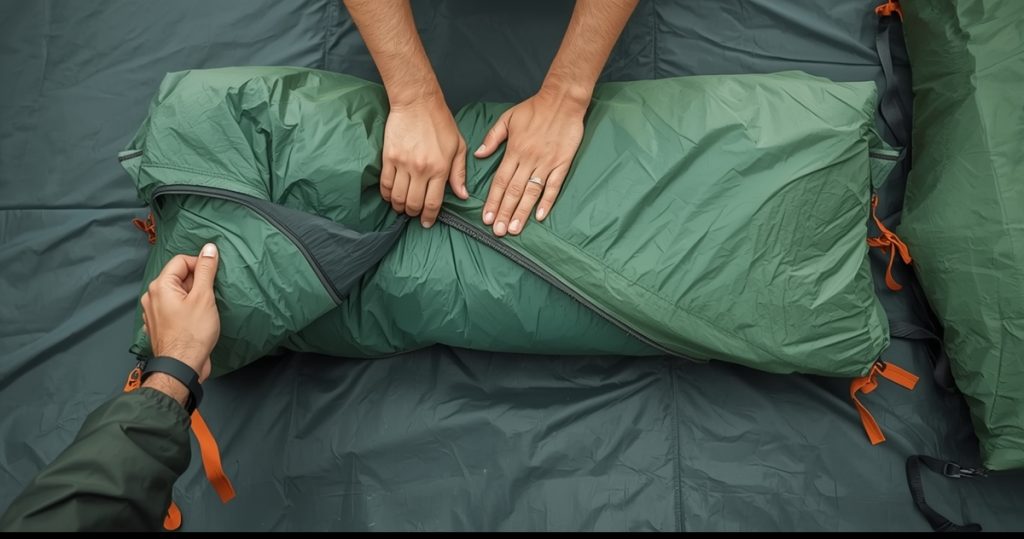As an Amazon Associate, I earn from qualifying purchases.
Proper tent storage is essential for preserving your gear and ensuring peak performance on every adventure. To store a tent properly, ensure it’s completely dry to prevent mold and mildew. Clean all parts—poles, stakes, fabric, and zippers—then stuff it into a breathable bag instead of folding it tightly. Store the tent in a cool, dry, dark place, away from sunlight and pests.
Proper storage is crucial to maintaining your tent’s durability and performance. Poor storage can lead to mold, waterproofing loss, and damage to zippers and seams. Follow these steps to ensure your tent stays in prime condition, ready for any adventure.
Contents
Why Proper Tent Storage Matters

Your tent faces harsh conditions every time you use it. Rain, UV rays, dirt, and constant folding and unfolding create stress that accumulates over time. How you store your tent between adventures directly impacts its lifespan and reliability.
Prevents Mold, Mildew, and Bad Odors
Moisture is your tent’s worst enemy during storage. Even tiny amounts of trapped moisture can create the perfect breeding ground for mold and mildew. These fungi don’t just create unpleasant smells—they actively break down tent fabrics and coatings, causing permanent damage that can’t be reversed.
Mold spores can also pose health risks, especially for people with allergies or respiratory conditions. Once mold establishes itself in your tent’s fabric, it’s nearly impossible to eliminate completely, often requiring expensive professional cleaning or gear replacement.
Avoids Material Breakdown and Seam Damage
Modern tent materials are remarkably durable, but they’re not indestructible. Polyester and nylon fabrics can degrade when stored improperly, especially when compressed for extended periods. The waterproof coatings that keep you dry are particularly vulnerable to damage from improper storage.
Seams bear the greatest stress in any tent design. When tents are stored in tight compression sacks for months, these critical areas experience constant tension that can weaken the fabric and compromise waterproof seam tape. This damage often doesn’t become apparent until you’re caught in a downpour.
Keeps Zippers, Poles, and Hardware Functional
Tent zippers contain lubricants and flexible materials that can deteriorate when exposed to extreme temperatures or moisture. Aluminum poles can develop corrosion, while elastic shock cords lose their stretch when stored under tension.
Stakes and guy-lines also benefit from proper storage. Bent stakes are frustrating to use, and tangled guy-lines waste valuable setup time when you arrive at camp.
Saves Time and Hassle Before Your Next Trip
Nothing dampens camping enthusiasm like discovering your tent is musty, damaged, or missing essential components the night before a trip. Proper storage means your tent will be clean, dry, and ready to go whenever adventure calls.
You’ll also save money by avoiding premature gear replacement. A well-maintained tent can provide decades of reliable service, while neglected gear may fail after just a few seasons.
How to Store a Tent (Step-by-Step)

Storing your tent correctly is crucial to preserving its quality, ensuring longevity, and keeping it ready for your next outdoor adventure. Proper tent care prevents issues like mold, mildew, and fabric deterioration, which can compromise its performance over time. By following a few simple steps, you’ll be able to keep your tent in excellent condition, extend its lifespan, and avoid costly repairs or replacements. Whether you’re a seasoned camper or a beginner, understanding how to store your tent properly is a fundamental skill that pays off in durability and convenience.
Follow these detailed steps to ensure your tent stays in excellent condition during storage:
Step 1: Shake Out Dirt and Debris
Begin by completely setting up your tent in a clean area—your backyard, garage, or even a large indoor space works well. This allows you to access all surfaces and components easily.
Shake out the tent body vigorously to remove loose dirt, sand, leaves, and other debris. Pay special attention to corners and pockets where particles tend to accumulate. Turn the tent inside-out and repeat the process to clear debris from the interior.
Don’t forget about the rainfly, footprint, and any other accessories. These components collect dirt and moisture just like the main tent body and require the same attention.
Step 2: Wash with Mild Soap and Cold Water (If Necessary)
If your tent is visibly dirty or has developed odors, it needs a thorough cleaning before storage. Set up a washing station using a large bathtub, outdoor space with a hose, or even a clean tarp spread on the ground.
Use only mild, non-detergent soap specifically designed for technical fabrics, or gentle dish soap as an alternative. Avoid regular laundry detergent, bleach, or fabric softeners, as these can damage waterproof coatings and fabric treatments.
Gently scrub problem areas with a soft brush or sponge. Focus on high-wear zones like the tent floor, door areas, and anywhere you notice stains or buildup. Rinse thoroughly with cold water to remove all soap residue, which can attract dirt and compromise fabric treatments if left behind.
Step 3: Allow Complete Drying
This is perhaps the most critical step in the entire storage process. Your tent must be completely dry before storage—and we mean completely. Even small amounts of residual moisture can cause problems over time.
Set up your tent in a well-ventilated area away from direct sunlight, which can degrade fabrics and coatings. If weather permits, outdoor setup is ideal. For indoor drying, ensure good air circulation and consider using fans to speed the process.
Allow at least 24 hours for drying, longer if conditions are humid. Check every component: tent body, rainfly, footprint, guy-lines, and even the stuff sacks. Everything should feel completely dry to the touch and smell fresh.
Step 4: Fold or Roll Loosely
Resist the temptation to stuff your tent back into its original compression sack immediately. Instead, fold it loosely or roll it gently to minimize stress on the fabric and coatings.
Start by laying the tent flat and folding it in half lengthwise, then in half again. Make gentle, loose folds rather than tight creases. Alternatively, you can roll the tent starting from one end, keeping the roll loose and relaxed.
The goal is to create a package that’s compact enough for storage without applying excessive pressure to any particular area of the fabric.
Step 5: Use a Breathable Storage Container
Your tent’s original stuff sack is designed for backpacking efficiency, not long-term storage. For storage, choose a breathable option that allows air circulation while protecting your tent from dust and pests.
Excellent storage containers include:
- Large mesh laundry bags
- Cotton pillowcases or duvet covers
- Breathable storage bins with ventilation holes
- Hanging storage bags designed for camping gear
Avoid plastic bags or airtight containers, which can trap moisture and create condensation problems.
Step 6: Choose the Right Storage Location
Store your tent in a cool, dry place with stable temperatures. Ideal locations include bedroom closets, dedicated gear rooms, or climate-controlled storage areas.
Avoid areas prone to temperature extremes or moisture, such as:
- Unheated garages or sheds
- Basements, especially those with moisture issues
- Attics that experience extreme heat
- Areas near water heaters, furnaces, or other heat sources
Keep your stored tent away from chemicals, solvents, and cleaning supplies, which can damage synthetic fabrics even through vapor exposure.
Best Practices for Long-Term Tent Storage

Proper long-term tent storage comes down to three essentials: clean, dry, and breathable. Always remove dirt and debris, let the tent dry completely, and avoid cramming it in a tight stuff sack. Store it loosely in a cotton or mesh bag in a cool, dry place away from sunlight, humidity, and chemicals. Check it every few months to air it out and spot issues early. With these simple steps, your tent will stay mold-free, protected, and ready for years of adventures.
Climate Control Is Key
Consistent temperature and humidity levels prevent the expansion and contraction cycles that stress tent materials. If you live in an area with extreme seasonal variations, consider investing in a small climate-controlled storage space for your most valuable gear.
Monitor humidity levels if possible. Ideal storage humidity ranges from 30-50%. Higher humidity encourages mold growth, while extremely dry conditions can make fabrics brittle.
Keep Components Organized
Store tent poles separately from the tent body to prevent punctures and reduce bulk. Bundle poles loosely together rather than keeping them under tension in their shock-cord configuration.
Organize stakes, guy-lines, and other hardware in clearly labeled containers. This prevents loss and makes setup much faster when you’re ready to camp again.
Use Cotton Storage Bags
Cotton pillowcases or dedicated cotton storage bags offer several advantages over synthetic alternatives. Cotton naturally regulates moisture levels, provides excellent breathability, and won’t trap odors like some synthetic materials can.
Large cotton duvet covers work excellently for family-sized tents or multiple pieces of gear. They’re inexpensive, washable, and widely available.
Rotate Storage Positions
Every few months, refold your tent in a different pattern or change its position in storage. This prevents permanent creases from forming and distributes wear patterns more evenly across the fabric.
Consider hanging your tent occasionally if you have space. Hanging storage eliminates fold lines entirely and allows the fabric to maintain its natural drape.
Regular Inspections
Check on your stored tent every three to six months, especially during the first year of storage. Look for signs of moisture, pest activity, or any developing issues you can address early.
This is also an excellent time to air out your tent briefly, inspect for any needed repairs, and ensure your storage system is working effectively.
Tips to Extend Your Tent’s Life

To extend your tent’s life, always dry it thoroughly before storing to prevent mildew. Protect the floor with a footprint or ground cloth and clean it regularly with mild soap and water. Store your tent in a cool, dry, well-ventilated area, away from sunlight. Use a breathable storage bag—never cram it into the stuff sack. Perform regular maintenance, like sealing seams and lubricating zippers, to keep your tent performing at its best.
Air Out After Every Trip
Even if your tent appears dry when you pack up camp, it likely contains moisture from condensation, humidity, or light precipitation. Set up your tent at home for a few hours after each trip to ensure complete drying.
This simple practice prevents most storage-related problems and takes only a few minutes of actual work.
Address Repairs Immediately
Small tears, loose seams, or zipper issues are much easier and cheaper to fix when they’re minor problems. Check your tent thoroughly after each trip and address any issues before storing.
Keep a basic tent repair kit that includes seam sealer, fabric patches, and zipper lubricant. Many repairs take just a few minutes but can prevent major failures later.
Protect Your Tent Floor During Use
Should I put a tarp under my tent? Absolutely. Using a footprint or tarp underneath your tent during camping provides crucial protection for the floor material. This barrier prevents punctures from rocks and sticks, reduces abrasion from rough ground, and makes cleanup much easier.
A proper footprint should be slightly smaller than your tent floor to prevent water from collecting between the layers. Many manufacturers offer custom footprints, but a basic tarp cut to size works just as well and costs much less.
Minimize UV Exposure
Ultraviolet radiation is one of the most damaging forces your tent faces. While you can’t avoid sun exposure entirely during camping, you can minimize it by choosing shaded campsites when possible and avoiding unnecessary setup in direct sunlight.
During storage, keep your tent away from windows and other UV sources.
Use Proper Setup Techniques
Learning how to make a table tent and other proper setup techniques reduces stress on your tent during use. Avoid over-tensioning guy-lines, which can distort the tent’s designed shape and create stress points.
Always use appropriate stakes for your soil conditions and replace bent or damaged stakes immediately.
Wrapping up
Proper tent storage is the easiest way to protect your investment and ensure peak performance on every trip. A few minutes of care after each camping trip can extend your tent’s life, giving you peace of mind and more adventures. While all tents have a limited lifespan, consistent maintenance can stretch that from five years to fifteen. The storage techniques in this guide are simple yet highly effective, keeping your tent clean, dry, and ready for your next outdoor journey.
Frequently Asked Questions
Can I store my tent in the garage?
Garages can be suitable for tent storage if they are consistently cool, dry, and climate-controlled. Avoid garages that experience extreme heat, freezing temperatures, or high humidity, as these conditions can damage tent materials over time.
Is it okay to keep a tent in its stuff sack?
Short-term storage in a stuff sack (a few weeks) is generally fine. For long-term storage, avoid leaving the tent compressed, as this can damage waterproof coatings, create permanent creases, and stress seams. Instead, store your tent loosely in a breathable container.
How do I dry a tent if I’m packing up in the rain?
If you must pack a wet tent, use a waterproof bag or plastic liner to protect other gear. Once home, set up and dry the tent as soon as possible—ideally within 24–48 hours. If immediate drying isn’t possible, store it in a breathable bag in a cool, dry location and prioritize drying at the first opportunity.
Should I wash my tent before storing it?
Only wash your tent if it’s visibly dirty or has developed odors. Excessive washing can wear down waterproof coatings and fabric treatments. For routine trips, simply remove debris and ensure the tent is fully dry before storage. Use mild soap designed for technical fabrics when washing.
How often should I inspect my stored tent?
Inspect your stored tent every 3–6 months, especially for long-term storage. Check for moisture, pest damage, or any developing issues. Regular inspections help catch problems early and maintain the tent’s longevity.
As an Amazon Associate, I earn from qualifying purchases.
